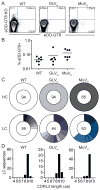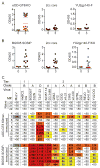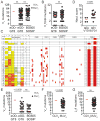Immunization for HIV-1 Broadly Neutralizing Antibodies in Human Ig Knockin Mice
- PMID: 26091035
- PMCID: PMC4604566
- DOI: 10.1016/j.cell.2015.06.003
Immunization for HIV-1 Broadly Neutralizing Antibodies in Human Ig Knockin Mice
Abstract
A subset of individuals infected with HIV-1 develops broadly neutralizing antibodies (bNAbs) that can prevent infection, but it has not yet been possible to elicit these antibodies by immunization. To systematically explore how immunization might be tailored to produce them, we generated mice expressing the predicted germline or mature heavy chains of a potent bNAb to the CD4 binding site (CD4bs) on the HIV-1 envelope glycoprotein (Env). Immunogens specifically designed to activate B cells bearing germline antibodies are required to initiate immune responses, but they do not elicit bNAbs. In contrast, native-like Env trimers fail to activate B cells expressing germline antibodies but elicit bNAbs by selecting for a restricted group of light chains bearing specific somatic mutations that enhance neutralizing activity. The data suggest that vaccination to elicit anti-HIV-1 antibodies will require immunization with a succession of related immunogens.
Copyright © 2015 Elsevier Inc. All rights reserved.
Conflict of interest statement
The authors declare no conflict of interest.
Figures





References
-
- Betz AG, Neuberger MS, Milstein C. Discriminating intrinsic and antigen-selected mutational hotspots in immunoglobulin V genes. Immunology today. 1993;14:405–411. - PubMed
Publication types
MeSH terms
Substances
Grants and funding
- UM1 AI100663/AI/NIAID NIH HHS/United States
- U19 AI109632/AI/NIAID NIH HHS/United States
- P01 AI100148/AI/NIAID NIH HHS/United States
- T32GM07739/GM/NIGMS NIH HHS/United States
- CAPMC/ CIHR/Canada
- HHMI/Howard Hughes Medical Institute/United States
- UL1TR000043/KL2TR000151/TR/NCATS NIH HHS/United States
- P01 AI094419-01/AI/NIAID NIH HHS/United States
- T32 GM007739/GM/NIGMS NIH HHS/United States
- P01 AI082362/AI/NIAID NIH HHS/United States
- R01 AI037526/AI/NIAID NIH HHS/United States
- KL2 TR000151/TR/NCATS NIH HHS/United States
- UL1 TR000043/TR/NCATS NIH HHS/United States
- AI037526/AI/NIAID NIH HHS/United States
- R37 AI037526/AI/NIAID NIH HHS/United States
- 280829/ERC_/European Research Council/International
- P01 AI094419/AI/NIAID NIH HHS/United States
LinkOut - more resources
Full Text Sources
Other Literature Sources
Molecular Biology Databases
Research Materials

